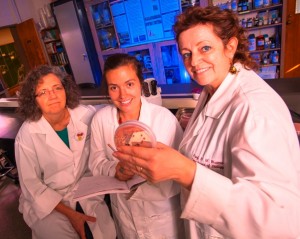This summer through a distinctive biology fellowship, Lindsay Marko ’14 was able to roll up her sleeves and get her hands dirty, literally, while working on a project that could help alleviate local water pollution.

Laurie Caslake, associate professor of biology (left}, Lindsay Marko ’14, and Nancy Waters, associate professor of biology, examine a culture they collected from the Delaware River and Oughoughton Creek.
Marko and fellow biology majors Briette Karanifilian ’14 and Rebecca LaRosa ’15 were this year’s recipients of David M. Nalven ’88 Summer Research Fellowships. Established in 1991 by Arthur Nalven, his wife, Rami, and their daughter, Lisa, in memory of David Nalven, the fellowship program gives students the opportunity to assist biology professors in field-based ecology research and commemorates the powerful experience that Nalven had as a summer research assistant for Nancy McCreary Waters, associate professor of biology.
“This fellowship program is a living tribute to David,” says Waters, who serves as the program’s adviser. “This program exemplifies the Lafayette community aspect in education at its finest.”
More than 40 students have benefited from the Nalven fellowship, close to half of whom have worked under Waters’ guidance on projects that include how pesticides affect monarch butterfly development, how disturbances in lake littoral (by the shore) zones impact vegetation patterns, and the role that invertebrates play in processing stream debris.
This summer, Marko studied mercury-resistant bacteria in a section of the Delaware River and Oughoughton Creek with Waters and Laurie Caslake, associate professor of biology. The researchers believe a coal ash spill in the area a decade ago may be contributing to the presence of these bacteria (coal ash contains metal contaminants).
LaRosa spent the summer researching an invasive species of turtle, the red-eared slider. Under the guidance of James Dearworth, associate professor of biology, she examined turtle populations and environmental parameters throughout the Northeast.
“The Nalven Fellowship gave me an opportunity to do research that I would not have had otherwise,” she says. “It was an invaluable learning experience.”
LaRosa’s research is important because the red-eared slider has been known to out-compete native species of turtles, and the movement of the turtle from its original habitat in the Southern United States to the Northeast could be affected by changes in climate. As the most common pet turtle, red-eared sliders are often released into the wild and then take over.
Karanifilian conducted research with Michael Butler, assistant professor of biology on the blue-green pigment molecule biliverdin.
“Biliverdin results from the degradation of senescent red blood cells and is responsible for the pigmentation of bile and eggshells in many bird species,” she says. “Until recently, biliverdin was thought to be a waste product with no crucial physiological function; however, recent research suggests that it may have immune defense properties.”
Karanifilian worked on developing protocols to quantify biliverdin in various tissues and then used those methods to measure biliverdin levels in birds, specifically European starlings to which she had issued immune challenges. This research could have implications for humans since biliverdin is also present in them before it is converted to a different structure. The research was published in the November 2013 issue of Comparative Biochemistry and Physiology.
For Karanifilian, one of her favorite opportunities this summer was to meet with the Nalven family and discuss her research.
“These fellowships allow us to expand upon past research experience and develop valuable skills that will help us throughout the remainder of our scientific careers,” she says.
